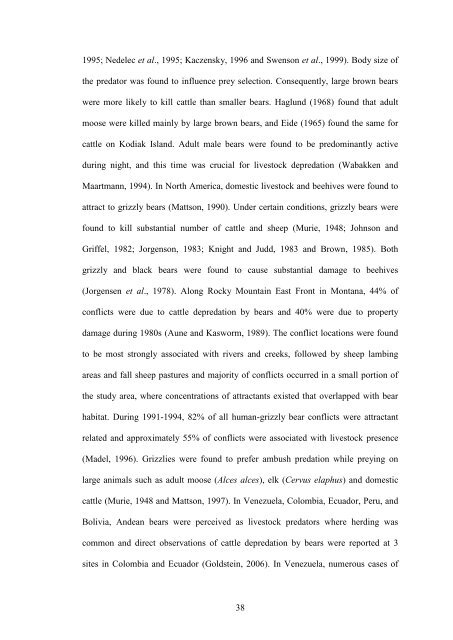Certificate - Etheses - Saurashtra University
Certificate - Etheses - Saurashtra University
Certificate - Etheses - Saurashtra University
Create successful ePaper yourself
Turn your PDF publications into a flip-book with our unique Google optimized e-Paper software.
1995; Nedelec et al., 1995; Kaczensky, 1996 and Swenson et al., 1999). Body size of<br />
the predator was found to influence prey selection. Consequently, large brown bears<br />
were more likely to kill cattle than smaller bears. Haglund (1968) found that adult<br />
moose were killed mainly by large brown bears, and Eide (1965) found the same for<br />
cattle on Kodiak Island. Adult male bears were found to be predominantly active<br />
during night, and this time was crucial for livestock depredation (Wabakken and<br />
Maartmann, 1994). In North America, domestic livestock and beehives were found to<br />
attract to grizzly bears (Mattson, 1990). Under certain conditions, grizzly bears were<br />
found to kill substantial number of cattle and sheep (Murie, 1948; Johnson and<br />
Griffel, 1982; Jorgenson, 1983; Knight and Judd, 1983 and Brown, 1985). Both<br />
grizzly and black bears were found to cause substantial damage to beehives<br />
(Jorgensen et al., 1978). Along Rocky Mountain East Front in Montana, 44% of<br />
conflicts were due to cattle depredation by bears and 40% were due to property<br />
damage during 1980s (Aune and Kasworm, 1989). The conflict locations were found<br />
to be most strongly associated with rivers and creeks, followed by sheep lambing<br />
areas and fall sheep pastures and majority of conflicts occurred in a small portion of<br />
the study area, where concentrations of attractants existed that overlapped with bear<br />
habitat. During 1991-1994, 82% of all human-grizzly bear conflicts were attractant<br />
related and approximately 55% of conflicts were associated with livestock presence<br />
(Madel, 1996). Grizzlies were found to prefer ambush predation while preying on<br />
large animals such as adult moose (Alces alces), elk (Cervus elaphus) and domestic<br />
cattle (Murie, 1948 and Mattson, 1997). In Venezuela, Colombia, Ecuador, Peru, and<br />
Bolivia, Andean bears were perceived as livestock predators where herding was<br />
common and direct observations of cattle depredation by bears were reported at 3<br />
sites in Colombia and Ecuador (Goldstein, 2006). In Venezuela, numerous cases of<br />
38

















